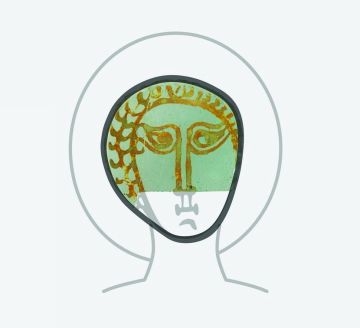The history of Vársziget (‘Castle Island’)
The Carolingian Age
The archaeological excavations of the last 60 years help us to discover the history of the place through findings and written documents. What was the real reason for choosing this place? There is no reliable answer. It must have been its border location and the fact that it can be easily defended.
It occurred circa A.D. 840 that Louis the German, the king of East Francia bestowed a fief situated in Alsó-Zalavölgy (Lower Zala Valley) on Prince Priwina, who established his seat in Zalavár-Vársziget (Zalavár ‘Castle Island’). He built his fortified manor house in the southern part of the island. The wooden church of John the Baptist that functioned to Christianize the pagans was built north of this manor house, more specifically in the centre of the island around A.D. 840. Priwina’s private church called the temple of the Blessed Virgin was finished A.D. 850, while martyr Adrian’s church as a destination of pilgrimage was completed around A.D. 855 by the support of the archbishop of Salzburg. By that time, Priwina’s seat evolved into an urbanized settlement.
Count Chezil, Priwina’s son became the ruler of Mosaburg (urbs paludarum; i.e. ‘Marsh Castle’) from A.D. 861 onwards. Saints Cyril and Methodius, to say ’the apostles of the Slavic peoples’, resided there on his courtesy for months at the end of A.D. 860s, after which Mosaburg was altered into the bona fide centre of Method’s archdiocese in Pannonia for several years. The place became one of the most preferred residences of Holy Roman Emperor Arnulf from A.D. 880s onwards. He ordered Braslav, his varsal to defend it against the Magyars A.D. 896. The Bavarians were calamitously defeated by the Magyars at the city of Brezalauspurc (German: Pressburg, Hungarian: Pozsony) A.D. 907.
The Árpádian Age
The settlement, which was abandoned in the 10th century, revived at the outset of the 11th century during the foundation of the Hungarian state. Priwina’s former private church was re-anointed in honour of Saint Adrian. The initial bailiffship hub of Zala County (Colon civitas), to say a palisaded enclosure was built north of it. According to the latest research, the area of the Colon County founded by Saint Stephen (Colon Civitas) included the areas of Somogy and Zala counties which were separated at the turn of the 11-12th centuries. The seat of Zala remained here and had been called Zalavár since then. The seat of Somogy was transferred to Somogyvár. The prosperous era of the centre dating to the Árpádian Age took place at the end of the 11th century, when the monastery and the church were reconstructed, and the bailiffship headquarters were also expanded with a keep and a church (today: Saint Stephen’s Chapel). The monastery was entrusted with notarial functions in the second half of the 13th century, and the secular administrative authority was relocated.
Mediaeval Times – the Early Modern Age
In the 14-15th centuries, vast private estates appeared in the vicinity of the abbacy. The mighty Rozgonyi family erected a fortress right in the neighbourhood. The monastery was fortified in the 1440s. Palatine Tamás Nádasdy, the governor of the abbacy had further defence facilities built in the middle of the 16th century. The monks abandoned the monastery in 1575. By that time, the monastery had become the royal border fortress belonging to the Kanizsa headquarters. After the castle of Kanizsa had fallen into the hands of the Turks in 1600, its significance increased, later on, after Kiskomárom had been destroyed in 1664, it became the most important defender of the border country and the water crossing points. The complex of buildings operated as a border fortress under Hungarian control until 1702, when Leopold I commanded its demolition by explosion as it had no military significance any more after the castle of (Nagy)Kanizsa had been reoccupied in 1690. There was no reason to keep it up any more and there was a strong fear of falling into the hands of the Kuruts.

| 
|
|








